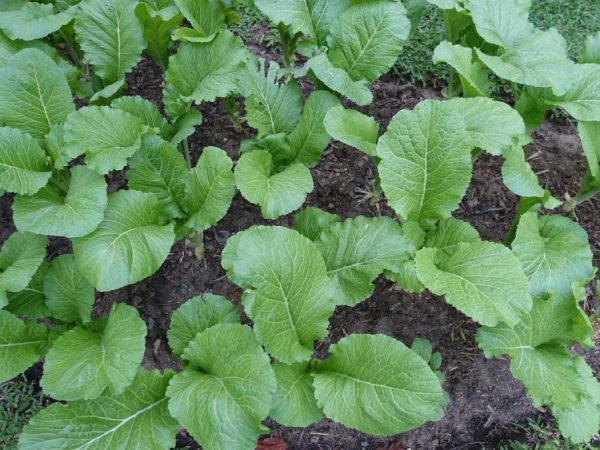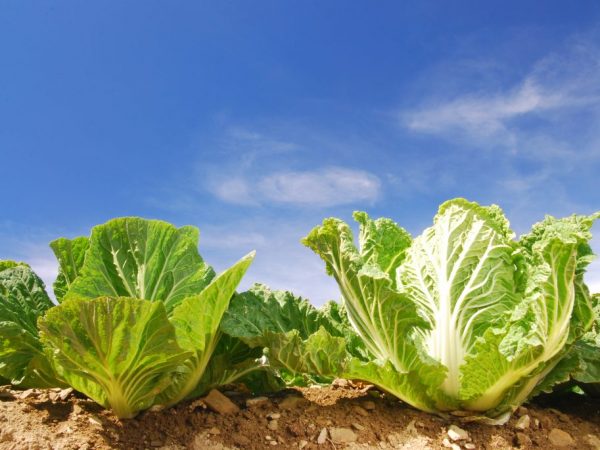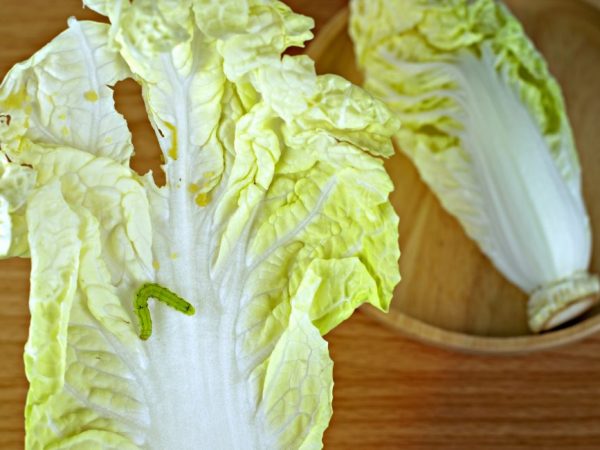Growing Chinese cabbage
Peking cabbage is a real storehouse of vitamins. Due to the delicate and excellent taste of the leaves, Peking cabbage is used in the preparation of various salads and snacks. Growing Peking cabbage in a summer cottage requires adherence to agricultural technology.
- Plant characteristic
- Seedling method of growing
- When to sow seeds
- Landing technique
- Care features
- Transplanting seedlings
- Soil preparation
- Transplant
- Care features
- Shelter
- Mulching and weeding
- Watering
- Fertilizers
- Bloom
- In greenhouse conditions
- How to protect from death
- Pests
- Diseases
- Prevention and treatment
- Collection and storage of outlets
- The best varieties of Chinese cabbage
- Early ripening
- Middle and late
- Late
- Ultra-ripe
- Regional varieties

Growing Chinese cabbage
Plant characteristic
This crop was first cultivated in China. Despite the fact that Chinese cabbage is a two-year-old cabbage variety, gardeners grow it as a one-year plant.
Peking is a cold-resistant cabbage variety. At a temperature of 3-4 °, the seeds of Peking cabbage begin to actively germinate. But the very process of development and intensive growth of plants begins at temperatures from 16 to 21 °. If the temperature indicators exceed the norm, the plants instantly begin to bloom en masse. In spring, the intensity of flowering is also affected by the length of daylight hours.
You can grow Peking cabbage in both seedling and non-seedling ways. However, growing Chinese cabbage in seedlings is considered the most rational. This method is used to obtain an early harvest of cabbages. Harvesting takes place three weeks after the seedlings are planted outdoors.
Seedling method of growing
Consider the secrets of growing this culture in a seedling way.
When to sow seeds
To get a high-quality harvest of stumps, it is very important to observe the timing of sowing seeds. We sow seeds of a garden crop in two months of the moment of planting in open ground, that is, at the end of March - in the first decade of April. Sowing during this period makes it possible to get not only an early, but also a high-quality harvest of heads of cabbage without defects and damage by pests. If you want to enjoy this vegetable all winter, then you need to sow Peking at the end of June.
Landing technique
There are some cultivation traits and basics that every gardener should master. Consider how to grow Chinese cabbage correctly.
- Sowing Chinese cabbage is recommended in a special soil mixture. For its preparation, two ingredients are used: coconut substrate and rotted manure in a 2: 1 ratio. In such loose soil, seedlings germinate faster and have a good root system.
- Given the tenderness of young plants and their root system, picking is contraindicated for them. Therefore, small containers are used for sowing Chinese cabbage seeds. It is best to plant seeds in peat tablets - three each.
- Seeds are planted to a depth of 1.5 cm. Peking cabbage seeds should be sown in a richly moistened soil mixture.Germination and cultivation of Chinese cabbage from seeds is carried out in a darkened room at room temperature.
After the mass appearance of sprouts, containers with seedlings are taken out in daylight.
Care features
The agricultural technology of this culture includes some care features:
- Temperature conditions. During this period of growth, seedlings require a low temperature - within 8-9 ° C. In such home conditions, crops grow gradually, without stretching. You need to keep them on the windowsill or on the glazed loggia and balcony.
- To properly grow Chinese cabbage at home, it will need regular watering, which is done as the soil dries. A day after moistening, the soil is loosened, which increases its moisture and air permeability.
- The time for rejection of bad sprouts falls on the period when several leaves appear on the seedlings. Strong plants are left, and weak ones are pinched off or carefully removed.
- After that, the seedlings are ready for transplanting.
Transplanting seedlings

Plants can be replanted when the third pair of leaves appears.
When a stable warmth comes, young plants can be transplanted to the site. The transplantation of young seedlings to the garden bed and their subsequent care is carried out at the stage of the appearance of three pairs of leaves in the shoots.
Soil preparation
It is best for such a culture to choose an area well-lit by the sun. The soil must be prepared in advance:
- she needs a deep digging in the fall;
- the soil is limed;
- in the spring, the site is fertilized with humus (a bucket of fertilizer per 1m2 of soil), then dug up again.
It is best to transplant young seedlings to an area with loose, moisture, breathable and nutritious soil. Before planting seedlings in the garden, the soil must be thoroughly moistened. Loamy soil is best suited for this crop.
It is recommended to plant this crop after:
- carrots;
- onion, garlic;
- cucumbers;
- potatoes;
- green manure plants.
It is not recommended to grow Chinese cabbage after tomatoes and beets. These plants suffer from the same diseases as cabbage.
Transplant
Planting Chinese cabbage in open soil is carried out after ten days of hardening. Young sprouts of Peking cabbage are taken out into the yard every day, increasing the time of its hardening every day.
As soon as the seedlings fully adapt to the outdoor conditions, they are planted on the site. Plants stop watering a few days before transplanting. Abundant watering is carried out before planting the sprouts.
Plants need to be planted at a distance of 20 cm from each other. In this case, the row spacing is 0.5 m.
If the cultivation of Peking cabbage is carried out in order to obtain stubs, the distance between the pits will be 30 cm, the row spacing will be 0.5 m.
We plant seedlings in pre-fertilized pits. In each hole, it is necessary to put 30 g of phosphorus fertilizers, 500 g of wood ash and 15 g of universal fertilizer - urea (urea). Fertilizer is mixed with soil, then watered abundantly. The seedlings, together with a peat tablet, are lowered into the dug hole, added dropwise and slightly trampled.
Care features

Take good care of your cabbage
Peking cabbage needs timely, competent care.
Shelter
After the planting of Peking cabbage in the garden is completed, it must be covered with a non-woven dense. This is necessary for the following purposes:
- So that the plantings are protected from spring frosts and sudden temperature changes.
- The first rays of the sun are very harmful to young plants and can burn them badly. Non-woven fabric will provide excellent protection from the scorching sun.
- Such a shelter will protect the plants from rotting during the period of frequent showers and rains.
- The cruciferous flea is one of the most dangerous parasites of cabbage, including Peking. The nonwoven fabric will protect young crops from damage by this parasite.
- Covered overnight with such material, the cabbage will begin to tie the heads faster.
Mulching and weeding
In the process of growing Peking cabbage, the planting area is mulched. Mulch is applied a couple of weeks after the plants are planted in the garden. A mixture of peat and small straw is used as mulch. Also, in the process of growth and development, the soil around the plants is gently loosened and weeds are removed as they grow.
Watering
If you decide to plant Peking cabbage, then you should provide it with competent watering, which is carried out no more than once a week. Plants are watered under the root with water at room temperature. During the watering process, it is very important that water does not fall on the delicate leaves, otherwise they can rot. Watering is carried out in the morning or evening.
To prevent the soil from drying out quickly, the next day after watering, the soil around the plants is loosened and mulched.
Fertilizers
Growing and caring for Peking cabbage involves repeated fertilization.
The first feeding is carried out two weeks after planting the seedlings in open soil. In this case, organic is used. There are several options for feeding that can be used for Peking:
- dissolve 1 liter. mullein in 10 liters. water;
- fertilizer from chicken manure - 1 liter. the substances are dissolved in 20 liters. water;
- herbal infusion - 1 liter. fresh and crushed raw materials are dissolved in 9 liters. water.
One plant spends liters. finished feeding. Cabbage planted in spring must be fed three times throughout the season. If you are going to grow this variety of cabbage in the summer, two additional dressings are enough for the entire growing season.
The second and third meals are carried out by the foliar method. They are introduced during the period of intensive plant growth in order to build up green mass. For these purposes, use the following solution:
- 1 l. hot water;
- 3 g of boric acid.
The resulting mixture is brought to a volume of 10 liters. cold water. Irrigation of the aboveground part of the plants is carried out in the evening. Under such conditions of care and maintenance, Peking grows very well and quickly, and most importantly, it gives a juicy and tasty harvest of cabbages.
Bloom

A head of cabbage can grow up to two kilograms
In regions of Russia with warm climatic conditions, the optimal planting dates are early spring or late autumn. In such conditions, when the temperature does not exceed the norm (7-9 °) and the daylight hours are shorter, the heads of cabbage turn out to be non-shooting. It is much easier to prevent the shooting of cabbage in the northern regions of Russia, in particular in Siberia, where the climate is cool.
At the beginning of growth, the plants form a small leaf rosette. Then, as the nutrients accumulate, the plants form an elongated head of cabbage. The heads are large, weighing up to 2 kg.
In greenhouse conditions
Consider how to properly grow Peking cabbage in greenhouse conditions. The technology of planting Chinese cabbage in a polycarbonate greenhouse is not much different from the features of planting in the garden. The same scheme and the density of planting are maintained. True, the conditions for growing this crop in a greenhouse are slightly different.
The temperature in the seedling greenhouse should be between 14-19 °. If the temperature rises above the norm, the plants will begin to release color. Plants prone to arrowing form loose and tasteless heads of cabbage. In addition, high temperatures can provoke the development of various diseases in plants.
The ideal humidity level in a greenhouse is around 80%.
Peking cabbage is planted in the greenhouse both by seed and seedlings. The optimal time for planting plants in greenhouse conditions is the middle or end of March. You can sow this crop with seeds - in mid-April. The seedling method makes it possible to get a crop a week earlier than the seedling method.
Planting seedlings or seeds is carried out in the same soil as when planting plants on open ground. In the process of growing, cabbage is fed with organic matter and mineral fertilizers containing nitrogenous substances.
How to protect from death
It is better not to grow Chinese cabbage if you do not have the opportunity to provide this crop with proper care and maintenance conditions. As practice shows, even experienced gardeners have problems growing this crop. Plants are often sick and attacked by pests. Therefore, it is important to know not only how to properly grow Peking cabbage, but also to protect it from being damaged by pathogenic microflora.
Pests
- sprout and cabbage flies;
- fleas;
- mole;
- moths;
- bugs, aphids;
- garden scoops;
- petiole mosquitoes;
- wireworms;
- flower beetles;
- bears.
Growths, black, reddish, yellow spots may appear on the leaves of infected plants. Holes in the leaves indicate the defeat of the heads of cabbage by leaf beetles.
Diseases
No less dangerous for planting are diseases such as fusarium wilting, black leg, alternaria, white rot, vascular bacteriosis, phomosis, ringing black spot and others.
If you notice black dots, stripes, yellowness on the leaves of plants, then they are affected by some kind of disease. The stalks affected by pests change their natural green color. They turn yellow and then blackened.
Prevention and treatment

Pests need to be dealt with
To grow a high-quality crop, you must first of all follow the rules for growing this crop and provide it with proper care.
If pests have already appeared on the site or plants are affected by some kind of disease, it is urgent to take action.
In the fight against fungal disease, systemic fungicides are used - Quadris, Fundazol, Topaz or Ridomil.
The plantings of this culture are not resistant to viral infections. Therefore, if you find black spots on the leaves of plants, they must be urgently removed from the site in order to protect healthy specimens. Damaged plants must be burned.
You can destroy pests on the leaves with the help of insecticides or insectoacaricides.
It is worth remembering that in pest control, the last treatment is allowed to be done no later than a month before harvest. Otherwise, the heads of cabbage will be toxic and unsuitable for human consumption.
Collection and storage of outlets
Heads of cabbage can be stored in a cool room until October. For long-term storage, cabbage crops planted in summer are suitable. Cabbage planted in spring does not last long.
Harvesting begins from the moment the heads of cabbage have acquired density. Heads of cabbage are wrapped in plastic wrap and placed in wooden boxes. The best place for long-term storage would be any cool basement room.
Storage of all varieties of cabbage requires certain conditions:
- thermal regime in the range from 0 to 3 °;
- air humidity - 90-95%.
In apartment conditions, in the absence of a basement for storing cabbage, you can use the glazed balcony. The main thing is that the temperature in the room does not fall below 0 °.
The best varieties of Chinese cabbage
Consider the most popular, high-quality and disease-resistant varieties of Peking cabbage. Currently, you can purchase Dutch and Japanese Peking hybrids by ordering them online on the manufacturer's website.
Early ripening
Early maturing varieties are resistant to shooting, and this is their main feature. Among gardeners, the following varieties are most popular:
- freckle;
- sprinkin;
- champion;
- asthen;
- tenderness;
- lyubasha;
- nagaoka 50;
- lenok.
Other early varieties and hybrid types of Peking are no less in demand - monaco, northern beauty, orange tangerine, optico, spectrum, tenderness, marfa, victoria, hydra.
The maturation period of early maturing varieties from the moment of sowing the seeds is about two months.Therefore, they are more suitable for the regions of central Russia.
Middle and late
This group includes the largest number of Peking cabbage varieties than the group of early and late species:
- wineglass;
- Garnet;
- the witch;
- roller;
- cha cha;
- autumn beauty;
- broken.
The ripening times for these varieties vary from 65 to 75 days. The weight of the cobs is 2.5-3 kg. In the regions of the middle lane, the most often cultivated varieties are cha-cha, brokken.
Late
Given that this vegetable ripens quickly enough, there are not so many late varieties:
- Nika;
- parking;
- monument;
- Russian size;
- nozaki.
Ultra-ripe
This group consists of two types of very tasty varieties called shanghai and broadleaf. High-yielding hybrids ripen already on the forty-fifth day after sowing the seeds.
The Khibinskaya variety belongs to semi-early maturing varieties. Heads of cabbage ripen in the open field for 40 days, in the closed field - 25 days.
Regional varieties
For central Russia and the Urals, the best varieties are: orange mandarin, Beijing express.

